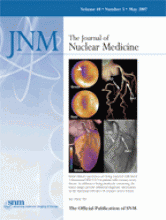REPLY: We thank our fellow researchers for their interest in our recent publication. The variable-threshold methods described in several studies are novel ways to determine gross tumor volume (GTV) for treatment planning with 18F-FDG PET (1–3). We agree that care must be taken in implementing this new technology, especially in the case of lung tumors for which no true gold standard for review of tumor volumes has been defined.
In our review of 20 peripheral non–small cell lung cancer lesions without atelectasis, we believed that the GTV defined by reports 50 and 62 of the International Commission on Radiation Units and Measurements was the best surrogate for a gold standard (4,5). The decision to model PET tumor volume on CT tumor volume for a one-to-one correlation defines the minimum volume to be treated using PET. We recognize that volumes defined for smaller tumors with PET may be a representation of tumor motion rather than tumor biology. The significance of this possibility has not yet been determined. Clinical judgment must be used in extending these findings to individual treatment plans, including cases with atelectasis or small tumors.
As we previously stated, Poisson distribution of pixel intensity does make the use of maximum SUV a somewhat less reliable starting point for tumor delineation. Maximum SUV, however, is an important biologic tumor parameter and yields essential information. Consider the scenario of a case of lung cancer with adjacent atelectasis. PET may be most helpful in the atelectatic lung when CT-based GTV is difficult to determine. An iterative process as described by Black et al. (2) may be useful in this scenario. However, the mild to moderate 18F-FDG uptake within the inflamed, atelectatic lung may alter the mean SUV and cause the inclusion of excess normal tissue.
Black et al. (2) described an alternate method for delineating PET-based GTV based on mean SUV derived from experiments involving stationary spheres. Although stationary spheres filled with 18F-FDG may serve as an adequate model for tumors without significant motion during treatment, Caldwell et al. (6) have shown that such spheres are inadequate for modeling tumors throughout respiratory motion. Furthermore, the limitation of a mean SUV of greater than 2 would have excluded half the tumors in our study. Models derived from stationary spheres should not be applied to clinical management of the respiratory system or of other systems subject to significant motion. Any model based on spheres must be examined with scrutiny because tumor heterogeneity is difficult to model.
For these reasons, our clinically derived model based on GTV generated from CT seems a more robust method to determine tumor extent on PET. Our current recommendations are to contour the lung tumor using 4-dimensional CT and to use 18F-FDG PET to clarify tumor versus no tumor or to clarify the distinction of tumor from surrounding atelectasis.
Footnotes
-
COPYRIGHT © 2007 by the Society of Nuclear Medicine, Inc.







